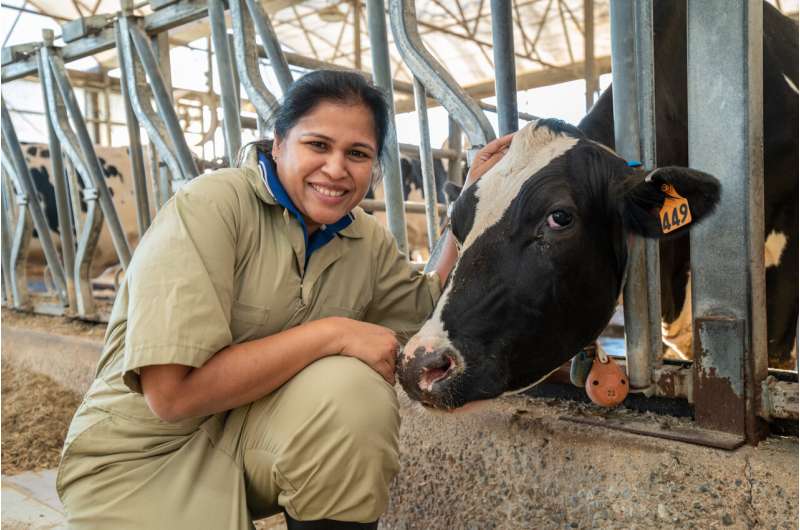This article has been reviewed according to Science X's editorial process and policies. Editors have highlighted the following attributes while ensuring the content's credibility:
fact-checked
peer-reviewed publication
trusted source
proofread
Could we breed cows that emit less methane?

Reducing methane emissions from livestock would benefit farmers and the environment. In a first step towards breeding low-methane-emitting cows, researchers from the University of Pennsylvania School of Veterinary Medicine and Pennsylvania State University have identified key differences between cows that naturally emit less methane than average.
The study, published in the Journal of Dairy Science, shows that low-emitting cows tend to be smaller and house different microbial communities, and these differences were not associated with reduced milk production or altered milk composition.
"We found that differences in methane emissions were accompanied by differences in microbial populations as well as their fermentation pathways," says senior author Dipti Pitta, the Mark Whittier and Lila Griswold Allam Associate Professor in the School of Veterinary Medicine. "Although we focused on dairy cows, the outcomes of this project can easily be applied to any other ruminant livestock, such as beef cattle and sheep."
Livestock—particularly cattle—produce 25% of the United States' methane, a greenhouse gas 28 times more potent than CO2. Reducing these emissions is a priority for farmers because, on top of the environmental benefit, reducing methane emissions could increase milk production and animal growth.
"Low methane emitters are more efficient cows," says Pitta, who works in the Center for Stewardship Agriculture and Food Security. "Methane formation is an energy-inefficient process, so reducing methane production gives that energy back to the cow to use for metabolic activities including improved growth rate and milk production."
In cows and other ruminants, methane is produced in the rumen, or first stomach, which is essentially a microbial fermentation vent that houses millions of microbes that help cows break down their food. During this digestion process, the microbes convert fiber into various chemicals including methane, which the cows release through burps.
Currently, the most commonly used method for limiting methane emissions is to feed cattle methane inhibitors that prevent rumen microbes from producing methane, but little is known about how these inhibitors affect the microbes. Prior studies have shown that synthetic methane inhibitors can cut methane emissions by 30% and seaweed derived methane inhibitors can cut emissions by 60% but may interfere with the animals' digestion.
An alternative approach would be to breed animals that naturally emit less methane. Cows naturally vary in how much methane they emit, and prior studies have suggested that this variation is partially heritable.
"We wanted to investigate whether any host genetic components or other host parameters like the microbiome are associated with cows that produce less methane," Pitta says. "Knowing these characteristics could enable us to selectively breed low methane emitting cattle."
To do this, Pitta's team first identified five low-methane-emitting cows and five high-methane-emitting cows from a herd of 130 lactating Holstein cows housed at Penn State. Then, the researchers set out to characterize the differences between these low and high emitters in terms of their genetics, milk production, rumen fermentation, and rumen microbiomes.
On average, the low emitters produced approximately 22% less methane than high emitters, corresponding to 278 pounds of methane per year per cow instead of 354 pounds per year. Overall, there was no difference between low and high methane emitters in terms of food intake, amount of milk produced, or milk composition, though low methane emitters did digest less of the food they consumed.
However, there were major differences in the rumen microbes and fermentation patterns of the low- and high-methane-emitting cows because methane is produced via microbial fermentation. Low-methane-emitting cows housed fewer types of microbes in their rumens, and their microbes were less likely to be methane producers or "methanogens."
"The differences in methane emissions were accompanied by differences in microbial populations as well as their fermentation pathways," Pitta says. "The fermentation used in high-methane emitters leads to higher hydrogen production, so there's more acetate which supports elevated methane formation."
When the researchers compared the gene expression of ruminal microbes in low vs. high emitters—basically a measure of how often the microbes are using these genes—they found that low emitters had lower levels of methyl-CoM reductase, an enzyme that is involved in methane formation.
Low-methane-emitting cows also tended to have smaller statures than high emitters. Though the connection between body size and methane emissions may not be immediately obvious, Pitta says it basically comes down to stomach size and the turnover of food within the rumen.
"There is a bit of crosstalk between the host and the microbiome in terms of whether the host is driving the microbiome, or the microbiome is driving the host," Pitta says. Smaller cows have smaller rumens, which means that they can eat less food at a given time. This means there's a faster passage rate of food through the gut, and this faster pace is less hospitable to the kinds of microbes that make methane.
Now, Pitta is investigating whether it's possible to selectively breed dairy cows to have efficient microbiomes. To even further reduce methane emissions, these results could be combined with other management strategies, for example by feeding synthetic or algal methane inhibitors to low-methane-emitting cows, Pitta says.
More information: N. Stepanchenko et al, Microbial composition, rumen fermentation parameters, enteric methane emissions, and lactational performance of phenotypically high and low methane-emitting dairy cows, Journal of Dairy Science (2023). DOI: 10.3168/jds.2022-23190
Journal information: Journal of Dairy Science
Provided by University of Pennsylvania

















